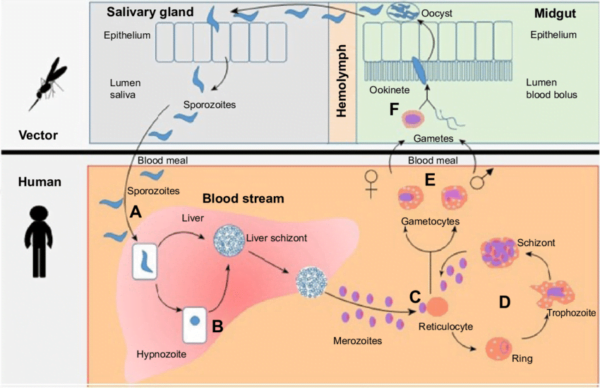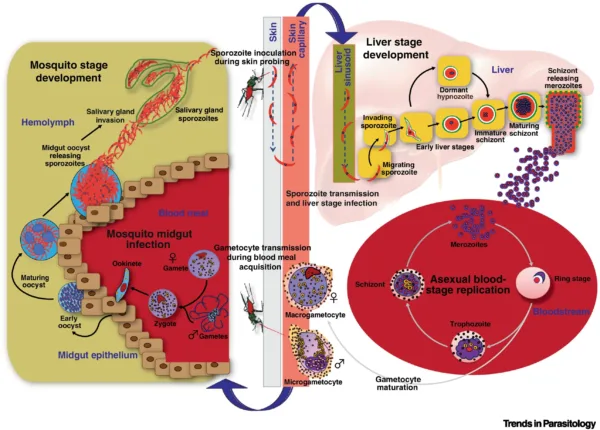Malaria, caused by various species of the Plasmodium parasite, has plagued humankind for centuries. One of the most prevalent and widely distributed species is Plasmodium vivax. Understanding its classification, characteristics, habitat, and lifecycle is crucial for effective control and treatment strategies. In this article, we discuss the fascinating world of Plasmodium vivax, exploring its unique features and life cycle.
1. Introduction to Plasmodium vivax
Plasmodium vivax is a protozoan parasite belonging to the phylum Apicomplexa. It is the causative agent of vivax malaria, a form of the disease that affects millions of people worldwide. Unlike Plasmodium falciparum, another deadly malaria parasite, P. vivax is generally considered less virulent. Nevertheless, it remains a significant public health concern, causing substantial morbidity and economic burden in endemic regions.
2. Classification Plasmodium vivax
Plasmodium vivax exhibits distinctive features that set it apart from other Plasmodium species. In terms of classification, P. vivax is categorized as follows:
- Kingdom: Protista
- Phylum: Apicomplexa
- Class: Aconoidasida
- Order: Haemosporida
- Family: Plasmodiidae
- Genus: Plasmodium
- Species: vivax
3. Habitat of Plasmodium vivax
- Widespread Geographic Distribution: Plasmodium vivax is prevalent in both temperate and tropical regions, with its presence observed across diverse geographic areas.
- Endemic Regions: The parasite is commonly found in parts of South America, Africa, the Indian subcontinent, Southeast Asia, the Middle East, and the Pacific Islands.
- Suitable Mosquito Vectors: P. vivax thrives in environments where suitable mosquito vectors, particularly Anopheles mosquitoes, and susceptible human hosts coexist.
- Mosquito Breeding Sites: Stagnant water bodies such as ponds, lakes, and slow-moving streams serve as ideal breeding grounds for Anopheles mosquitoes, facilitating the spread of P. vivax.
- Climate Factors: Factors like temperature, humidity, and rainfall influence the distribution and prevalence of the parasite in different regions.
4. Characteristics of Plasmodium vivax
Plasmodium vivax, a protozoan parasite responsible for causing vivax malaria, is a significant public health concern worldwide. This species of Plasmodium exhibits several distinctive characteristics that set it apart from other malaria-causing parasites. Understanding these features is crucial in combatting vivax malaria effectively. Here are the key characteristics of Plasmodium vivax:
Morphology:
Plasmodium vivax exists in various stages during its lifecycle, each with distinct morphological characteristics. These stages include sporozoites, merozoites, gametocytes, and the sexual forms that develop in the mosquito vector.
Prevalence:
Plasmodium vivax is widely distributed and prevalent in regions with temperate climates and lower altitudes. It is particularly common in areas of Asia, Latin America, the Middle East, and some parts of Africa.
Relapse Potential:
One of the most unique features of P. vivax is its ability to remain dormant in the liver after the primary infection, leading to relapses months or even years later. This dormancy is known as the hypnozoite stage and is responsible for recurrent vivax malaria episodes.
Vector Preference:
Plasmodium vivax primarily depends on Anopheles mosquitoes as its vector for transmission to humans. Various Anopheles species can transmit P. vivax, contributing to its wide geographic distribution.
Red Blood Cell Invasion:
P. vivax exhibits a preference for young and immature red blood cells (reticulocytes). This preference differentiates it from Plasmodium falciparum, another malaria-causing species that shows a higher preference for mature red blood cells.
Short Duration of Febrile Episodes:
Compared to Plasmodium falciparum, vivax malaria typically causes less severe symptoms and shorter febrile episodes. However, the recurrent nature of vivax malaria due to relapses can still have significant health impacts.
Geographical Variation:
The characteristics and behavior of P. vivax can vary depending on the geographic location and the presence of specific mosquito vectors. Different strains and subtypes of P. vivax may show distinct genetic and antigenic traits.
Antibody Response:
Infected individuals develop antibodies in response to P. vivax infection. These antibodies play a role in the immune response against the parasite and may offer some level of immunity against subsequent infections.
Drug Resistance:
Like other Plasmodium species, P. vivax has shown some level of resistance to certain antimalarial drugs. Monitoring drug resistance patterns is crucial for effective treatment and control of vivax malaria.
Vulnerable Populations:
P. vivax disproportionately affects vulnerable populations, including young children, pregnant women, and individuals with compromised immune systems.
5. Lifecycle of Plasmodium vivax
Plasmodium vivax is a protozoan parasite that completes its life cycle in two hosts – humans and female Anopheles mosquitoes. The sexual phase of the life cycle occurs in mosquitoes, while asexual reproduction takes place in humans. When an infected female Anopheles mosquito bites a human, it transmits infectious sporozoites into the bloodstream, initiating the asexual phase. Subsequently, the life cycle continues as merozoites attack red blood cells (RBCs), leading to recurring malaria symptoms.

I. Asexual Stage – Sporozoite to Merozoite
A. Plasmodium vivax Transmission: Sporozoites from Mosquitoes to Humans
- Sporozoites are the infectious forms of P. vivax that enter the human bloodstream when an infected mosquito bites for a blood meal.
- Sporozoites travel to the liver, where the pre-erythrocytic schizogony begins.
B. Pre-erythrocytic Schizogony: Sporozoites Invading Liver Cells
- Formation of Schizonts: Maturation of Sporozoites in the Liver
- Sporozoites multiply and mature into schizonts within liver cells during the pre-erythrocytic schizogony.
- Schizonts rupture, releasing thousands of merozoites into the bloodstream.
C. Dormant Hypnozoites: P. vivax’s Silent Threat in the Liver
- Some merozoites formed during pre-erythrocytic schizogony become hypnozoites, dormant forms of the parasite that can persist in the liver for extended periods.
- Hypnozoites can reactivate, causing recurrent malaria infections if left untreated.
D. Erythrocytic Schizogony: Merozoites Attacking Red Blood Cells
- Trophozoites Formation: Merozoite Transformation in RBCs
- Merozoites invade red blood cells (RBCs) and transform into immature trophozoites.
- Schizonts Maturation: Development of Schizonts in RBCs
- Trophozoites mature into schizonts within RBCs, continuing the erythrocytic schizogony.
- Merozoite Release: Schizont Rupture Causing Recurring Malaria Symptoms
- Schizonts rupture, releasing merozoites into the bloodstream, leading to recurring malaria symptoms and the spread of the infection.
II. Sexual Stage – From Gametocytes to Sporozoites
A. Formation of Gametocytes in Humans
- Microgametocytes and Macrogametocytes Differentiation
- Within human RBCs, some trophozoites differentiate into gametocytes, marking the beginning of the sexual stage.
- Male gametocytes (microgametocytes) and female gametocytes (macrogametocytes) are formed.
B. P. vivax Transmission: Human to Mosquito
- When an infected female Anopheles mosquito bites a human, it takes up gametocytes with the blood, initiating the transmission of the parasite to the mosquito.
C. Ex-flagellation: Microgametocytes Forming Microgametes
- Microgametocytes undergo ex-flagellation, a process where they divide to form flagella-like microgametes or sperms.
D. Development of Macrogametocytes: Female Gametes with a Reception Cone
- Macrogametocytes become non-motile female gametes with a reception cone, making them ready for fertilization.
E. Fertilization Process: Syngamy and Zygote Formation
- When a mosquito bites an infected human, microgametes penetrate macrogametes through the reception cone, leading to fertilization and the formation of diploid zygotes or synkaryons.
F. Ookinete Formation and Mosquito’s Gut Penetration
- The zygotes transform into motile ookinetes, which penetrate the stomach wall of the mosquito.
G. Oocyst Stage and Sporogony
- Asexual Multiplication: Oocysts Producing Sporozoites
- The ookinetes form oocysts on the mosquito’s stomach wall, undergoing asexual multiplication known as sporogony.
- The oocysts mature and produce thousands of sporozoites.
- Sporozoites Release: Infection Readiness during Mosquito Bites
- Mature oocysts rupture, releasing sporozoites into the mosquito’s body cavity, making it ready to infect humans during a blood meal.

Understanding the Plasmodium vivax life cycle is essential for effective malaria control and prevention strategies. Continuous research and intervention are vital to reduce the burden of this deadly disease. By targeting both the asexual and sexual stages of the parasite’s life cycle, we can develop more efficient strategies to combat malaria and improve global health outcomes. Public awareness, early diagnosis, and appropriate treatment remain critical in the fight against P. vivax malaria. Together, we can work towards eradicating this ancient menace and achieving a malaria-free world.
6. Conclusion
Plasmodium vivax remains a significant global health challenge, particularly in regions where suitable mosquito vectors and vulnerable human populations coexist. Understanding the parasite’s classification, characteristics, habitat, and lifecycle is crucial for implementing effective control measures, such as vector control strategies, use of insecticide-treated bed nets, and prompt diagnosis and treatment of infected individuals.
Efforts to combat Plasmodium vivax must be multifaceted, involving collaboration between governments, international organizations, researchers, and healthcare providers. Advancements in malaria research, along with the development of new tools and interventions, offer hope in the fight against this ancient and resilient parasite.
Terms related to Lifecycle of Plasmodium vivax
What are sporozoites?
Sporozoites are the infective stage of Plasmodium vivax transmitted to humans by infected female Anopheles mosquitoes during a blood meal. They initiate the infection by migrating to the liver.
What are hepatocytes?
Hepatocytes are liver cells where sporozoites develop after entering the liver. They undergo asexual replication, producing thousands of merozoites.
What are merozoites?
Merozoites are daughter cells resulting from the asexual replication of sporozoites in hepatocytes. They invade red blood cells (RBCs) to continue the infection cycle.
What are gametocytes?
Gametocytes are the sexual forms of Plasmodium vivax that develop in the bloodstream after multiple rounds of asexual replication within RBCs. They play a crucial role in the sexual reproduction of the parasite in the mosquito.
What is the exoerythrocytic stage?
The exoerythrocytic stage occurs within the liver, where sporozoites develop into merozoites within hepatocytes before being released into the bloodstream.
What is the erythrocytic stage?
The erythrocytic stage occurs within the RBCs of the human host. Merozoites invade RBCs, multiply, and cause the destruction of infected RBCs, leading to febrile episodes.
What is a febrile episode?
A febrile episode is a recurrent cycle of fever, chills, and flu-like symptoms experienced by the infected individual during the erythrocytic stage. It corresponds to the release of merozoites and destruction of infected RBCs.
What are hypnozoites?
Hypnozoites are dormant forms of Plasmodium vivax that remain in the liver after the primary infection. They can reactivate later, leading to relapses of vivax malaria.
What is a vector?
The vector, such as the female Anopheles mosquito, transmits Plasmodium vivax from an infected human to another human host. Mosquitoes ingest gametocytes during a blood meal and transmit sporozoites in their saliva.
What are oocysts?
Oocysts are structures forming on the mosquito’s gut wall during the sporogonic cycle. They house developing sporozoites before being released to migrate to the mosquito’s salivary glands.
Learn more
References
- World Health Organization. (2021). Malaria. https://www.who.int/news-room/fact-sheets/detail/malaria
- CDC. (2021). Parasites – Malaria. https://www.cdc.gov/parasites/malaria/index.html
- Garg, S., Chakrabarti, R., Singh, R., & Singh, A. (2012). Antimalarial drug resistance: an overview. Tropical Parasitology, 2(2), 30–41.
- Mueller, I., et al. (2009). Key gaps in the knowledge of Plasmodium vivax, a neglected human malaria parasite. The Lancet Infectious Diseases, 9(9), 555-566.
- Baird, J. K. (2013). Evidence and implications of mortality associated with acute Plasmodium vivax malaria. Clinical Microbiology Reviews, 26(1), 36–57.
- Sharma, Y. D. (2004). Molecular basis of relapse in Plasmodium vivax malaria. The Indian Journal of Medical Research, 120(5), 369–377.
- Cowman, A. F., Healer, J., & Marapana, D. (2016). Malaria: Biology and Disease. Cell, 167(3), 610–624.
- Delves, M., & Plouffe, D. (2018). The transmission biology of human malaria. Cold Spring Harbor Perspectives in Medicine, 8(7), a025479.
- White, N. J. (2011). Determinants of relapse periodicity in Plasmodium vivax malaria. Malaria Journal, 10(1), 297.
- Douglas, N. M., et al. (2011). Plasmodium vivax Recurrence following falciparum and mixed species malaria: Risk factors and effect of antimalarial kinetics. Clinical Infectious Diseases, 52(5), 612-620.